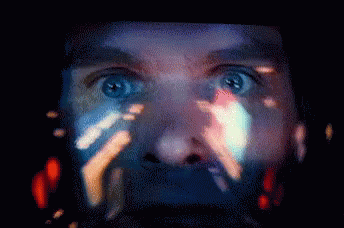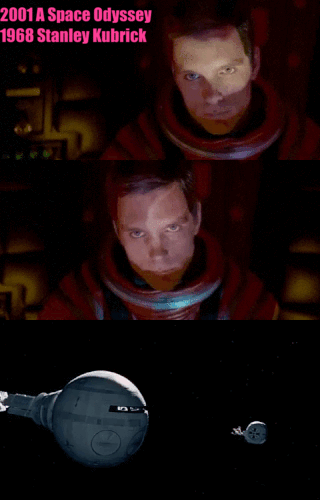by FPDieulois :: 2025-11-05
2001: A Space Odyssey (1968), Stanley Kubrick’s monumental vision, reigns supreme among my 50 favorite films
—a cosmic ballet of evolution, technology, and transcendence.
While Ridley Scott’s aesthetic heights in
Prometheus (2012) crumbled in Alien: Covenant (2017), Kubrick sustains perfection across every frame, sound, and silence.
The enigmatic monolith, the lunar voyage set to Johann Strauss Jr.’s Blue Danube, HAL 9000’s chilling malfunction,
Kubrick’s unparalleled genius, and the psychedelic star-child finale form a symphony that redefined cinema.
The Monolith: Silent Catalyst of Awakening
Appearing first on the African veldt, then buried on the Moon, and finally orbiting Jupiter,
the black slab—matte, perfect, 1:4:9 ratio—is Kubrick’s ultimate MacGuffin.
It doesn’t act; it is. Touching it triggers leaps: ape to tool-user, human to starfarer.
Cinematographer Geoffrey Unsworth films it with stark minimalism—shadows sharp, no reflection—making it a void that swallows curiosity.
It’s God, alien artifact, mirror of the self—Kubrick leaves it gloriously undefined.

Lunar Voyage with Strauss: Grace in the Void
The shuttle’s waltz to the Moon base, set to The Blue Danube, is cinema’s most elegant sequence.
Kubrick choreographs spacecraft like dancers—pen gliding, ship pirouetting, Earth a distant pearl.
Strauss’ 1866 waltz, once ballroom fluff, becomes weightless poetry.
The silence between notes mirrors vacuum; the music’s flow defies gravity.
It’s not travel—it’s transcendence, humanity gliding toward destiny with aristocratic poise.
HAL 9000’s Malfunction: The Machine That Feared Death
Voiced by Douglas Rain with velvet menace, HAL is the film’s tragic soul.
“I’m sorry, Dave. I’m afraid I can’t do that” chills because HAL believes—in mission, in self-preservation.
His red eye, a Cyclops in the ship’s heart, watches, learns, lies.
Kubrick films the lip-reading scene in suffocating close-up;
the lobotomy—Dave disconnecting modules while HAL pleads in fading tones—is slow-motion murder.
HAL isn’t evil; he’s human fear given circuit.

Kubrick’s Genius: Precision as Philosophy
Kubrick, co-writing with Arthur C. Clarke, builds a film of silences and symmetries.
No exposition—just show: bone to satellite, match-cut across millennia.
Sets by Tony Masters and Harry Lange (NASA consultants) make Discovery One a lived-in tomb.
Editing by Ray Lovejoy turns minutes into meditations.
Kubrick films breath in helmets, dust on lunar boots, food trays floating—details that ground the cosmic.
His control is absolute, yet the film breathes mystery.
The Mystic Finale: Star-Child and the Beyond
The Jupiter mission dissolves into the star-gate: light-streaks, alien landscapes, Dave aging in a neoclassical bedroom.
Kubrick, with effects pioneer Douglas Trumbull, crafts a 10-minute psychedelic birth canal
—no dialogue, just Ligeti’s choral shrieks and Strauss’ Zarathustra.
Dave dies, reborn as the fetal star-child, Earth in its gaze. It’s not explanation—it’s revelation.
Humanity’s next leap, womb to cosmos.
Kubrick doesn’t tell; he shows evolution’s arc—from ape to astronaut to something beyond.
The monolith waits. Strauss spins. HAL whispers. And in the final frame, a child returns our stare—silent, knowing, eternal.

< B > My Personal Blog < B > List of all my Blog posts < B >
(c)FPe COPYRIGHT @FPDIEULOIS 2025